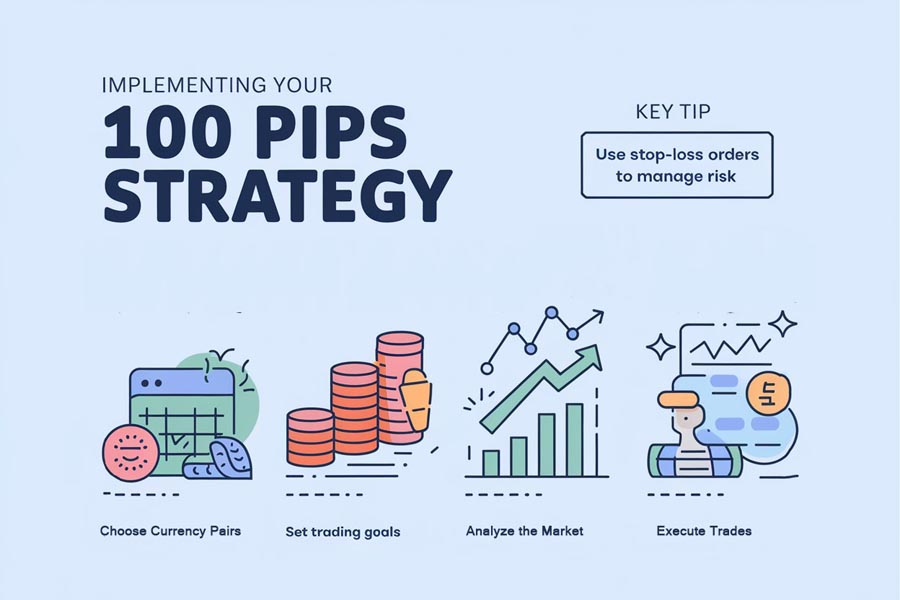Is it possible to consistently make 100 pips a week in forex trading? The answer is yes, it is achievable, but it requires a disciplined approach, solid strategy, and effective risk management. This article explores the “100 pips a week” strategy, a method aimed at securing steady profits in the forex market by targeting a realistic goal of 100 pips per week.

For traders seeking consistent returns, the concept of earning 100 pips per week has gained significant traction. This approach offers a structured path to potential profitability, emphasizing steady accumulation over high-risk trades. To implement this strategy effectively, choosing the right forex broker is crucial. A reputable online forex broker or forex trading broker provides the necessary tools and conditions for executing this strategy successfully.
In this comprehensive guide, we’ll delve into the intricacies of the 100 pips a week strategy, providing you with actionable insights to elevate your forex trading game. Whether you’re a novice seeking a reliable income stream or an experienced trader refining your approach, this article will equip you with the knowledge to work towards achieving 100 pips per week consistently.
Understanding the 100 Pips a Week Strategy

What Are Pips?
Before diving into the strategy, it’s essential to understand what pips are. A pip, short for “percentage in point,” is the smallest price move that a given exchange rate can make. For most currency pairs, a pip is the fourth decimal place in the price quote. For example, if the EUR/USD moves from 1.1000 to 1.1001, that’s a one pip movement.
The Value of a Pip
The value of a pip varies depending on the currency pair and the lot size you’re trading. For most currency pairs where the U.S. dollar is the quote currency, the value of one pip per standard lot (100,000 units) is $10. Understanding pip value is crucial for proper position sizing and risk management in your 100 pips a week strategy.
The Concept Behind 100 Pips a Week
The 100 pips a week strategy is based on the principle of setting a realistic and achievable target for forex traders. Instead of aiming for large, sporadic gains, this approach focuses on consistent, smaller profits that accumulate over time. By targeting 100 pips per week, traders can potentially:
- Reduce risk exposure
- Maintain a more stable emotional state
- Build a steady income stream
- Improve overall trading discipline
Compound Growth Potential
One of the key advantages of the 100 pips a week strategy is the potential for compound growth. If a trader consistently achieves 100 pips per week and reinvests their profits, they could potentially see significant account growth over time. For example, starting with a $10,000 account and achieving 2% growth per week (assuming 100 pips equals roughly 2% account growth), the account could theoretically grow to over $27,000 in a year, not accounting for any losses or withdrawals.
Implementing the 100 Pips a Week Strategy

1. Choose the Right Currency Pairs
Selecting the appropriate currency pairs is crucial for the success of this strategy. Consider these factors:
- Volatility: Look for pairs with enough movement to reach your pip target.
- Liquidity: Highly liquid pairs offer tighter spreads and easier entry/exit points.
- Trading hours: Choose pairs that align with your preferred trading schedule.
Popular pairs for the 100 pips a week strategy include EUR/USD, GBP/USD, and USD/JPY due to their consistent volatility and high liquidity.
Volatility Analysis
To identify suitable pairs, conduct a volatility analysis:
- Calculate the Average True Range (ATR) for various currency pairs.
- Compare the ATR to your 100 pip target.
- Choose pairs with an ATR that allows for realistic achievement of your weekly goal.
Read More: 500 Pips a Week
2. Develop a Solid Risk Management Plan
Risk management is the cornerstone of successful forex trading. To implement the 100 pips a week strategy effectively:
- Set stop-loss orders: Protect your capital by limiting potential losses.
- Use proper position sizing: Never risk more than 1-2% of your account on a single trade.
- Implement a risk-reward ratio: Aim for at least a 1:2 risk-reward ratio to ensure profitability.
Position Sizing Calculator
Develop or use an existing position sizing calculator to determine the appropriate lot size for each trade. This ensures you’re risking a consistent percentage of your account on each trade, regardless of the currency pair or entry price.
3. Create a Trading Plan
A well-structured trading plan is essential for achieving 100 pips per week. Your plan should include:
- Entry and exit criteria: Define clear rules for opening and closing positions.
- Time frames: Decide which time frames you’ll analyze and trade on.
- Technical indicators: Choose reliable indicators that align with your strategy.
- Fundamental analysis: Consider economic events that may impact your chosen currency pairs.
Sample Trading Plan Template
Here’s a basic template for your 100 pips a week trading plan:
- Weekly Goal: 100 pips
- Daily Goal: 20 pips (5 trading days)
- Maximum Daily Loss: 30 pips
- Risk per Trade: 1% of account balance
- Preferred Currency Pairs: EUR/USD, GBP/USD, USD/JPY
- Trading Session: London/New York overlap
- Entry Criteria: [Your specific rules]
- Exit Criteria: [Your specific rules]
- Key Technical Indicators: [Your chosen indicators]
4. Utilize Multiple Time Frame Analysis
To increase the accuracy of your trades and improve your chances of achieving 100 pips a week:
- Start with higher time frames (daily or 4-hour charts) to identify the overall trend.
- Move to lower time frames (1-hour or 15-minute charts) to fine-tune your entry points.
- Use the lowest time frame (5-minute or 1-minute charts) for precise execution.
Read More: 300 pips a week
Time Frame Correlation
Ensure your analysis across different time frames aligns. For example:
- Daily chart shows an uptrend
- 4-hour chart confirms the uptrend and shows a pullback
- 1-hour chart shows a bullish reversal pattern at a support level
This alignment increases the probability of a successful trade.
5. Implement Proper Trade Management
Once you’ve entered a trade, managing it effectively is crucial:
- Trail your stop-loss: Move your stop-loss to break-even once the trade is in profit.
- Take partial profits: Consider closing part of your position as you approach your target.
- Use a trailing stop: Lock in profits as the trade moves in your favor.
Scaling Out Technique
Consider using a scaling out technique to secure profits while allowing for further gains:
- Close 1/3 of your position at your initial target (e.g., 30 pips)
- Move your stop-loss to break-even
- Close another 1/3 at the second target (e.g., 60 pips)
- Trail your stop-loss for the remaining 1/3 to potentially capture extended moves
Key Strategies for Achieving 100 Pips a Week

1. Trend Following
Identifying and trading with strong trends can significantly increase your chances of reaching the 100 pips per week target. Use these techniques:
- Moving averages: Utilize multiple moving averages to confirm trend direction.
- Trendlines: Draw trendlines to identify potential support and resistance levels.
- Price action: Look for higher highs and higher lows in an uptrend, or lower lows and lower highs in a downtrend.
Advanced Trend Identification
Incorporate these advanced techniques for more accurate trend identification:
- Use the Average Directional Index (ADX) to measure trend strength
- Implement the Ichimoku Cloud for trend direction and potential support/resistance levels
- Utilize Fibonacci retracements to identify potential reversal points within the trend
2. Breakout Trading
Breakouts can offer excellent opportunities to capture quick pips. To implement this strategy:
- Identify key support and resistance levels: Use horizontal lines, trendlines, or Fibonacci retracements.
- Wait for a convincing breakout: Look for increased volume and a strong candle closing beyond the level.
- Use false breakout filters: Implement techniques to avoid getting trapped in false breakouts.
Breakout Confirmation Techniques
To avoid false breakouts:
- Wait for a retest of the broken level
- Use the 50% rule: Wait for the price to move at least 50% of the previous candle’s range beyond the breakout level
- Confirm with volume: Look for a significant increase in volume during the breakout
Read More: 50 Pips a Week
3. News Trading
Major economic news releases can create significant price movements. To capitalize on these events:
- Stay informed: Keep an economic calendar handy to track important releases.
- Understand the impact: Learn how different news events affect various currency pairs.
- Implement a news trading strategy: Decide whether to trade before, during, or after the news release.
News Trading Strategies
- Straddle Strategy: Place pending orders above and below the current price before news release
- Fade the Initial Move: Wait for the initial volatility to subside, then trade in the opposite direction of the initial spike
- Trend Continuation: If the news aligns with the overall trend, enter in the trend direction after the initial volatility
4. Range Trading
During periods of consolidation, range trading can be an effective way to accumulate pips. Consider these tactics:
- Identify the range: Use support and resistance levels to define the trading range.
- Trade the bounces: Enter long positions near support and short positions near resistance.
- Use oscillators: Implement indicators like RSI or Stochastic to confirm overbought or oversold conditions.
Range Trading Indicators
- Bollinger Bands: Trade bounces off the upper and lower bands
- Commodity Channel Index (CCI): Use extreme readings to identify potential reversal points
- Donchian Channels: Trade breakouts from the channel for potential range expansion
Overcoming Challenges in the 100 Pips a Week Strategy
While the 100 pips a week strategy can be highly effective, it’s not without its challenges. Here are some common obstacles and how to overcome them:
1. Emotional Control
Challenge: The pressure to reach the weekly target can lead to emotional trading decisions.
Solution:
- Implement a strict risk management plan.
- Focus on the process rather than the outcome.
- Practice mindfulness techniques to maintain emotional balance.
2. Overtrading
Challenge: Attempting to force trades to reach the 100 pip target can lead to overtrading.
Solution:
- Stick to your trading plan religiously.
- Accept that some weeks may not reach the target due to market conditions.
- Focus on high-probability setups rather than trade frequency.
3. Adapting to Market Conditions
Challenge: Market volatility and trends can change, making it difficult to consistently achieve 100 pips.
Solution:
- Regularly review and adjust your strategy based on current market conditions.
- Be flexible in your approach, adapting to ranging or trending markets as needed.
- Develop multiple strategies to suit different market environments.
Measuring Success and Tracking Progress
To ensure you’re on track with the 100 pips a week strategy:
- Keep a detailed trading journal: Record all trades, including entry/exit points, rationale, and outcomes.
- Calculate your average weekly pip gain: This helps identify areas for improvement.
- Review your performance regularly: Conduct weekly and monthly reviews to refine your approach.
- Set realistic milestones: Start with smaller targets and gradually work up to 100 pips per week.
OpoFinance Services: Your Partner in Achieving 100 Pips a Week
When implementing the 100 pips a week strategy, having a reliable and regulated forex broker is crucial. OpoFinance, an ASIC-regulated broker, offers a comprehensive suite of services tailored to help traders achieve their goals. With its cutting-edge trading platform, competitive spreads, and robust risk management tools, OpoFinance provides the ideal environment for executing the 100 pips a week strategy.

One standout feature of OpoFinance is its innovative social trading service. This allows traders to connect with and learn from experienced professionals who have consistently achieved or exceeded the 100 pips per week target. By following successful traders and analyzing their strategies, you can refine your own approach and increase your chances of reaching your weekly pip goal.
Conclusion
The 100 pips a week strategy offers a structured and disciplined approach to forex trading that can lead to consistent profits over time. By focusing on realistic goals, implementing solid risk management practices, and continuously refining your strategy, you can increase your chances of success in the forex market.
Remember, achieving 100 pips per week is not always guaranteed, and there will be challenging periods. However, by staying committed to your trading plan, adapting to market conditions, and leveraging the tools and services provided by regulated brokers like OpoFinance, you can work towards building a sustainable and profitable forex trading career.
Is it realistic to consistently achieve 100 pips a week in forex trading?
While achieving 100 pips a week is a realistic goal for many traders, it’s important to understand that consistency can vary. Market conditions, individual skill levels, and risk management practices all play a role. Some weeks may exceed 100 pips, while others fall short. The key is to focus on long-term performance rather than fixating on weekly targets.
How much capital do I need to start implementing the 100 pips a week strategy?
The capital required depends on various factors, including your risk tolerance, position sizing, and the currency pairs you trade. Generally, it’s recommended to start with at least $5,000 to $10,000 to allow for proper risk management and flexibility in trade sizing. However, some traders may begin with smaller accounts and adjust their pip targets proportionally.
Can the 100 pips a week strategy be combined with other trading methods?
Absolutely! In fact, incorporating multiple strategies can enhance your overall trading approach. The 100 pips a week goal can serve as a framework, while you implement various trading methods such as trend following, breakout trading, or range trading to achieve your target. The key is to ensure that any additional strategies align with your risk management principles and overall trading plan.







